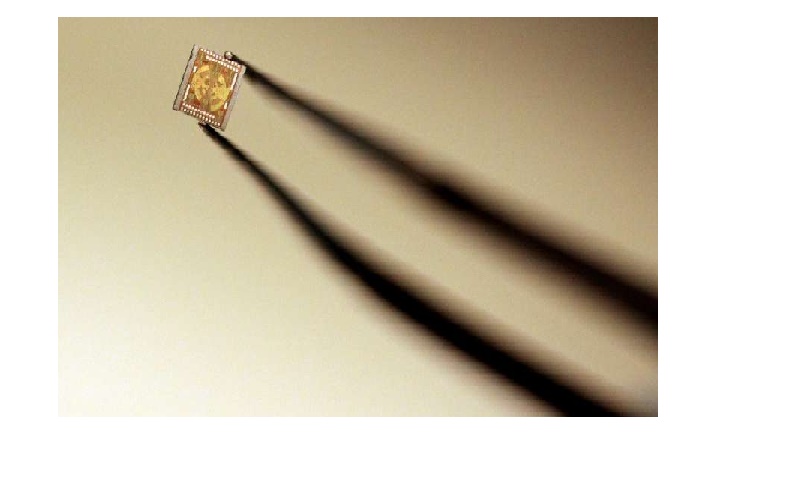

Electromagnetic pulses lasting one millionth of a millionth of a second may hold the key to advances in medical imaging, communications and drug development. But the pulses, called terahertz waves, have long required elaborate and expensive equipment to use.
Now, researchers at Princeton University have drastically shrunk much of that equipment: moving from a tabletop setup with lasers and mirrors to a pair of microchips small enough to fit on a fingertip.
In two articles recently published in the IEEE Journal of Solid State Circuits, the researchers describe one microchip that can generate terahertz waves, and a second chip that can capture and read intricate details of these waves.
“The system is realized in the same silicon chip technology that powers all modern electronic devices from smartphones to tablets, and therefore costs only a few dollars to make on a large scale” said lead researcher Kaushik Sengupta, a Princeton assistant professor of electrical engineering.
Terahertz waves are part of the electromagnetic spectrum—the broad class of waves that includes radio, X-rays and visible light—and sit between the microwave and infrared light wavebands. The waves have some unique characteristics that make them interesting to science. For one, they pass through most non-conducting material, so they could be used to peer through clothing or boxes for security purposes, and because they have less energy than X-rays, they don’t damage human tissue or DNA.
Terahertz waves also interact in distinct ways with different chemicals, so they can be used to characterize specific substances. Known as spectroscopy, the ability to use light waves to analyze material is one of the most promising—and the most challenging—applications of terahertz technology, Sengupta said.
To do it, scientists shine a broad range of terahertz waves on a target then observe how the waves change after interacting with it. The human eye performs a similar type of spectroscopy with visible light—we see a leaf as green because light in the green light frequency bounces off the chlorophyll-laden leaf.
In two recently published articles, researchers Kaushik Sengupta (left), an assistant professor of electrical engineering, and Xue Wu (right), a Princeton graduate student in computer science, describe one microchip that can generate
Read more at: https://phys.org/news/2017-02-future-terahertz-chips.html#jCp
The challenge has been that generating a broad range of terahertz waves and interpreting their interaction with a target requires a complex array of equipment such as bulky terahertz generators or ultrafast lasers. The equipment’s size and expense make the technology impractical for most applications.
Researchers have been working for years to simplify these systems. In September, Sengupta’s team reported a way to reduce the size of the terahertz generator and the apparatus that interprets the returning waves to a millimeter-sized chip. The solution lies in re-imaging how an antenna functions. When terahertz waves interact with a metal structure inside the chip, they create a complex distribution of electromagnetic fields that are unique to the incident signal. Typically, these subtle fields are ignored, but the researchers realized that they could read the patterns as a sort of signature to identify the waves. The entire process can be accomplished with tiny devices inside the microchip that read terahertz waves.
“Instead of directly reading the waves, we are interpreting the patterns created by the waves,” Sengupta said. “It is somewhat like looking for a pattern of raindrops by the ripples they make in a pond.”
Daniel Mittleman, a professor of engineering at Brown University, said the development was “a very innovative piece of work, and it potentially has a lot of impact.” Mittleman, who is the vice chair of the International Society for Infrared Millimeter and Terahertz Waves, said scientists still have work to do before the terahertz band can begin to be used in everyday devices, but the developments are promising.
“It is a very big puzzle with many pieces, and this is just one, but it is a very important one,” said Mittleman, who is familiar with the work but had no role in it.
On the terahertz-generation end, much of the challenge is creating a wide range of wavelengths within the terahertz band, particularly in a microchip. The researchers realized they could overcome the problem by generating multiple wavelengths on the chip. They then used precise timing to combine these wavelengths and create very sharp terahertz pulses.
In an article published Dec. 14 in the IEEE Journal of Solid State Circuits, the researchers explained how they created a chip to generate the terahertz waves. The next step, the researchers said, is to extend the work farther along the terahertz band. “Right now we are working with the lower part of the terahertz band,” said Xue Wu, a Princeton doctoral student in electrical engineering and an author on both papers.
“What can you do with a billion transistors operating at terahertz frequencies?” Sengupta asked. “Only by re-imagining these complex electromagnetic interactions from fundamental principles can we invent game-changing new technology.”
The round was led by the fund of Dan Caine, Chairman of the Joint Chiefs…
Company raises $5.75M to lead the shift toward AI Engine Optimization Brandlight, the first-of-its-kind AI…
Infineon further strengthens its number one position in automotive microcontrollers and boosts systems capabilities for…
Rohde & Schwarz has achieved a significant milestone, receiving approval of detection capability from the…
April 8, 2025 - Avnet ASIC, a leading provider of ASIC and SoC full turnkey…
Acquisition expands Siemens’ offering in PCB design for the SMB market and enables greater process…